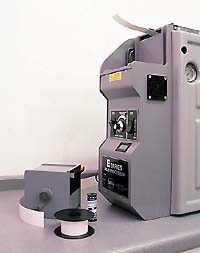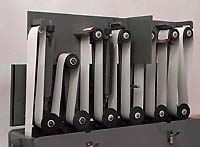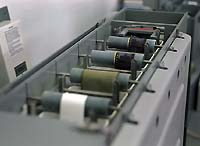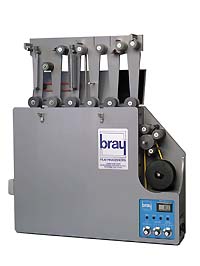

Two guys turn up at door. They lift a sort of flat, grey object which looks like a demonstration model of a deep tank processor out of the back of a van and put it on the darkroom bench. Some well-used Tetenal E-6 gets tipped into it.

Left: Richard pretends to be a mobile processing person, with the Bray C-41 dry to dry processor in that bag on his shoulder.
Just over an hour later, I have a clean roll of E-6 on a light-box. While it was processing, Geoff Bray and Ian Griffiths set up an even smaller Midget model which fits into a shoulder bag, fill it up with C-41 chemicals made up on the spot from dry powders, and after having a sandwich we unroll a dry roll of colour negs.
These machines are totally different from other low-cost film developing systems. There are no spirals to load, no bottles to fill or tanks to wash out, and almost any number of films can be processed in sequence.
Bray processors were first devised for the 16mm and 35mm movie industry. They use a leader-belt, a length of blank polyester which is threaded through a sequence of miniature deep tanks via rollers and guides. The films to be processed are wound into a roomlight loading cartridge, and can be spliced together into a reel. No darkroom is necessary for 35mm, but spliced-up rollfilms need a special two-chamber loading box and a changing bag or darkroom.

The film preparation is the longest part of the process, and the only time when your personal attention is needed. Once the exposed tip of the film inside the daylight cartridge is taped to the leader-belt, and the cartridge pushed home against the entry port of the processor, the machine can be switched on and left. The last film you spliced to the reel in the loading cartridge is, of course, the first to be processed.
At the end of the processing time, which is under an hour for full six-bath E-6 and about 15 minutes for the first C-41, the processed and perfectly dried films are spooled at the exit end of the machine and the white leader-belt which you had spliced on to the first film in the cartridge is left in position in the tanks, ready for your next run.
My experience with most benchtop processors has been that drying is their weakest point. Hot air forced up through a loaded spiral is slow and prone to marks; unloading and putting films in a cabinet calls for personal attention, and once again leads to inevitable drying marks. The Bray E-Series passes film through a hot air chamber after squeegeeing that critical central �run� off the surface. It produces a finish as good as the large lab machines.


Leader-belt machines, which pass the film over rollers and guides, are often criticised for a tendency to scratch longitudinally. The design of the Bray miniature rollers, which only need to be wide enough for a 70mm film at the most, curves the emulsion inwards slightly and puts most of the support and drive friction at the outer edges of the film-base side. The critical inside area of the emulsion side is kept well away from mechanical handling. Our films were totally free from scratches despite the process of winding on to a reel, splicing, feeding off the reel and finally winding back again when dry.

The Midget C-41 machine, left, costing only in the mid-�2,000s to buy in one-shot chemical form, was for 35mm only and aimed at Press users. After the demonstration, I suggested to Geoff Bray that a version capable of handling 120 rolls would be popular with wedding and portrait photographers in out-of-town locations. The simple modular design of the machines makes this possible and Bray expect to show such a version at the PMA exhibition this autumn.
The larger E-6 machine costs in the mid-�4,000s without replenishment systems (these and a water softening, filtering and temperature control unit take the price over �6,000). The Tetenal chemistry used, a 5-litre kit of which 3.6 litres is needed to load the tanks each time, had been repeatedly demonstrated without replenishment and over 30 films had been processed. It could have done with filtering, as could our darkroom air drawn in to the dryer unit, but otherwise the results were still on target.
The minimal depth of these machines means they can be mounted in constricted areas like a corridor or the back of a darkroom bench. Wall-mounting or a speed-frame stand are both options, and a plumbed-in wash can be used with the replenishment system.
While the processors are limited in capacity � four E-6 films an hour is typical � they are low in capital cost, simple to maintain, require only a 13 amp wall socket and run happily without any plumbing or replenisher systems if so required. The results are first-class and any reasonably intelligent person could be trained to load and use a Bray processor in a day.
For imaging bureaux, the Bray E-6 machine permits same-day turnround of digital filmwriter slides and adds hardly anything to overall system investment. For minilabs, the Bray E-6 combined with a Pakon or similar mounter adds a service which very few currently have, and for which a premium price can be charged.
For photographers, the C-41 machine gives almost instant access to dry transproofs on Vericolor 35mm print film, and in the proposed 120 form will allow Fotovix proofing within half an hour of the end of a portrait session, or at wedding receptions. The C-41 Midget version is fully portable and could be used at banqueting or social events. Both machines can be converted temporarily to black and white or other processes using the comprehensive but secure speed and temperature controls.
We went through all procedures in detail, including how to put a 120 roll in the middle of 35mms. These procedures do not warrant a blow-by-blow account; anyone buying a Bray processor will have full demonstration training and subsequent support. I can vouch for the fact that everything works, parts are affordably priced, and the designer-manufacturers know exactly what it�s all about.